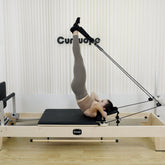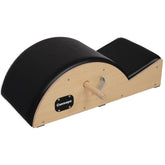Which Pilates exercises do you think pose the highest risk of injury?
Are you putting your body at risk?
Pilates is a popular form of exercise that focuses on strength, flexibility, and body awareness. It can be a great way to improve your fitness level and overall well-being. However, not all Pilates exercises are created equal. Some can be dangerous if not performed correctly or if you have certain health conditions. In this blog post, we will explore 10 Pilates exercises that can be risky and provide alternatives to ensure your safety.

10 Dangerous Pilates Exercises:
1. Neck Pull
The Neck Pull exercise involves lying on your back and curling your upper body off the mat while reaching for your toes. This exercise puts a lot of strain on the neck and can lead to neck pain or injury. Instead, try the Chest Lift exercise, which targets the same muscles without the risk to your neck.
2. Scissors
Scissors is a Pilates exercise that involves lying on your back and lifting one leg while the other leg hovers above the ground. This exercise can strain the lower back and hip flexors. A safer alternative is the Single Leg Stretch, where you keep both feet on the ground while engaging your core.
3. Shoulder Bridge
The Shoulder Bridge exercise requires lifting your hips off the mat while keeping your feet and shoulders grounded. This exercise can put excessive pressure on the neck and shoulders. Instead, try the Bridge exercise, which focuses on the glutes and hamstrings without straining the upper body.
4. Teaser
The Teaser exercise is an advanced Pilates move that involves balancing on your tailbone while reaching for your toes. This exercise requires a high level of core strength and can strain the lower back. A safer alternative is the Roll Up, which targets the core muscles without the risk of excessive strain.
5. Jackknife
The Jackknife exercise involves lying on your back and lifting your legs and torso off the mat to form a V shape. This exercise can put a lot of pressure on the lower back and neck. Instead, try the Hundred exercise, which is a challenging Pilates move that targets the core without compromising your spine.
6. Corkscrew
The Corkscrew exercise requires lying on your back and rotating your legs in a circular motion. This exercise can strain the lower back and neck if not performed properly. A safer alternative is the Crisscross exercise, which engages the oblique muscles without putting excessive stress on the spine.
7. Neck Circles
Neck Circles involve rotating your head in a circular motion, which can strain the neck and lead to discomfort or injury. Instead, try the Neck Retraction exercise, where you gently retract your neck and hold the position to improve posture and alleviate tension.
8. Roll Over
The Roll Over exercise requires lying on your back and lifting your legs overhead. This exercise can put excessive strain on the neck and spine. A safer alternative is the Leg Circles exercise, which targets the hip flexors and improves flexibility without compromising your neck and back.
9. Swan Dive
The Swan Dive exercise involves lying on your stomach and lifting your upper body off the mat while extending your arms forward. This exercise can compress the lower back and strain the neck. Instead, try the Sphinx exercise, which provides a similar back extension without the risk of excessive compression.
10. Control Balance
The Control Balance exercise is an advanced Pilates move that requires balancing on your tailbone while extending your legs. This exercise can put a lot of strain on the lower back and neck. A safer alternative is the Double Leg Stretch, which targets the core muscles without compromising your spine.
How to perform these exercises safely?
1. Start with a proper warm-up to prepare your body for the workout.
2. Focus on maintaining proper alignment and form throughout each exercise.
3. Engage your core muscles and breathe deeply during each movement.
4. Start with beginner-level variations and gradually progress to more advanced versions.
5. Listen to your body and modify or skip any exercises that cause pain or discomfort.
Remember, safety should always be a priority when practicing Pilates or any other form of exercise. If you are unsure about any exercise or have any health concerns, it is best to consult with a qualified Pilates instructor or healthcare professional.
Stay safe, stay strong, and enjoy your Pilates journey! If you're new to Pilates, consider taking a class or working with a certified instructor to ensure proper form and technique. Stay consistent with your practice, and you'll soon experience the amazing benefits of Pilates!





